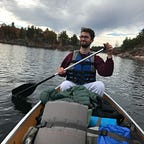There’s a place I go to in my mind, often. A northern lake, late summer. Water lilies in bloom, petals closing for the evening. Woodsmoke from a cooking fire drifting up into white pines as the night sky turns black. Loon-song, always loon-song.
In Anishinaabemowin, the place I’m in is called Shebahonaning, or canoe passage. It’s English name is Killarney. I’m sitting by the water with three of my closest friends, contemplating an evening swim. Joseph dives in first, the rest of us joining shortly after. Houman treads in with his socks. The lake is cool, a welcome break from the warmth of the cookfire. Our eyes adjust to the darkness, and a few stars begin to shine on the lake. The night is tinged with a sense of post-adolescent nostalgia; we are all leaving for university soon, in different cities. With this in mind, we dry off and decide to sleep outside.
We pull our sleeping bags up to the edge of the lake, just above the high-water mark. Clearing a few stray stones, we scan the quartzite rock underneath us for the best place to lay down. We follow the lines deeply etched into its surface, ghosts of the glaciers this stone used to cradle. A good place to be with the stars.
None of us being particularly capable astronomers, we look for the same familiar Greek shapes in the night sky (though this is far from a Greek sky) — Ursa Major, Ursa Minor, list ends there. We trace the path of the milky way, our usual sense of separation to the rest of space disappearing. Over time, the stars begin to warp our conversation, both slowing it down and opening it up. I ask the night sky questions, silently, individually, mostly self-importantly about the future. What life will I build? How will I be different, or the same, next time I’m back here? The stars have little to say; they specialize in the past. Sleep comes on quickly.
Returning to Shebahonaning in my mind, many years later, the stars encourage me to ask different questions from what was on my mind that evening. What else could I have seen in the stars, if I knew how to look? What stories would the night sky have told me?
My first hope at an answer to this question came in the form of a book, the lovingly assembled Ojibwe Sky Star Map, Constellation Guide. Star knowledge is best learned from elders, not from books, but I read and listened carefully to the knowledge it had to share. I had become so used to referring to the Greek / Western constellations as “the constellations” that they had come to assume a position of primacy every time I looked at the stars. I didn’t bother to think about how little sense those constellations made here in Shebahonaning. What do Greek gods know about the forests of northern Ontario? I apologized to Ojiig (fisher) and Maang (loon) for not having seen them in the night sky before.
For millennia, Anishinaabe people have been carefully naming, observing, and telling stories about the sky above us. I will not retell the stories here, as they are not mine to share, but I want to comment briefly on the impact they have had on me. Hearing a loon call on a northern lake and seeing its shape reflected in the stars above communicates something about this place the little dipper never can. The Maang (loon) constellation becomes an anchor point for teachings and stories that tell us how to live properly on this land. The night sky is as much a site of storytelling as any good landscape, and should be treated with appropriate reverence. Placemaking occurs above, as it does below.
The morning after we slept by the rocks, I remember thinking mostly of water. I was thirsty. This was our first camping trip together, and we didn’t own a filter yet. Boiling lake-water and waiting for it to cool down was the only way to get clean drinking water.
I walked down to the lake with a pot, hoping to boil enough to fill a few bottles before making the long paddle back to our access point. Houman was drying his socks from the previous night by the fire (they were slightly charred by this point), and William and Joseph were packing up our tent.
As I stepped down to the lake, the loon I had heard singing the night before floated past me. Or at least I thought it was that loon. It’s feathers were mostly black, interspersed with hundreds of white dots — the milky way recreated in miniature on the loon’s back. Loons are usually shy and avoid humans, spending most of their time on open water. With this in mind, I was glad to share some time with the loon.
Soon, the loon disappeared on the other side of a quartzite ledge, and I walked back to our cooking fire. We finished breakfast, loaded the canoes, and filled our water bottles for the paddle ahead.
Pushing off into the glacial lake later that morning, I thought of the loon, stars, and the space between them.
